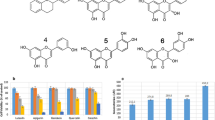Summary
Human interferon alpha (IFN-α) and interferon gamma (IFN-γ) inhibit African swine fever (ASF) virus replication in Vero cells. IFN-α and IFN-γ exert a synergistic inhibition. Human tumor necrosis factor (TNF) does not inhibit ASF virus replication in this cell line, but in combination with IFNs it has antiviral enhancing activity. Analysis of the mechanism of inhibition suggests that the action of these cytokines blocks a step that comes prior to DNA replication. The 2′-5′ A synthetase activity is induced in Vero cells by treatment with these cytokines and is activated after ASF virus infection. More interesting is the finding that continuous treatment with IFN-α cures Vero cells from lytic and persistent infections with ASF virus. A potential application of IFN for the treatment of animals carrying the virus is suggested.
Similar content being viewed by others
References
Anderson KP, Fennie E (1987) Adenovirus early region 1A modulation of interferon antiviral activity. J Virol 61: 787–795
Cayley PJ, Davies J, McGullagh KG, Kerr IM (1984) Activation of the ppp(A2′p)nA system in interferon-treated, herpes simplex virus infected cells and evidence for novel inhibitors of the ppp(A2′p)nA-dependent RNase. Eur J Biochem 143: 165–174
Crespi M, Chiu MN, Struthers JK, Schoub BD, Lyons SF (1988) Effect of interferon on Vero cells persistently infected with Sendai virus compared to Vero cells persistently infected with SSPE virus. Arch Virol 98: 235–251
Enjuanes L., Carrascosa AL, Moreno MA, Viñuela E (1976) Titration of African swine fever (ASF) virus. J Gen Virol 32: 471–477
Esparza I, Gonzalez JC, Viñuela E (1988) Effect of interferon-α, interferon-γ and tumor necrosis factor on African swine fever virus replication in porcine monocytes and macrophages. J Gen Virol 69: 2973–2980
Feduchi E, Carrasco L (1987) Adenovirus infection reverses the antiviral state induced by human interferon. FEBS Lett 214: 153–157
Garcia-Barreno B, Sanz A, Nogal ML, Viñuela E, Enjuanes L (1986) Monoclonal antibodies of African swine fever virus. Antigenic differences among field virus isolates and viruses passaged in cell cultures. J Virol 58: 385–392
Gil-Fernandez C, Garcia-Villalon D (1988) A model virus-cell system to study the persistence of African swine fever virus. Arch Virol 100: 161–169
Hess WR (1981) African swine fever: a reassessment. Adv Vet Sci Comp Med 25: 349–356
Joklik WK (1985) Interferons. In: Field BN (ed) Virology. Raven, New York, pp 281–307
Kitajewski J, Schneider RJ, Safer B, Munemitsu SM, Samuel CE, Thimmappaya B, Shenk T (1986) Adenovirus VAI RNA antagonizes the antiviral action of interferon by preventing activation of the interferon-induced eIF2-α kinase. Cell 45: 195–200
Lengyel P (1982) Biochemistry of interferons and their actions. Annu Rev Biochem 52: 252–282
Maniatis T, Fritsch EF, Sambrook J (1982) Molecular cloning: a laboratory manual. Cold Spring Harbor Laboratory, Cold Spring Harbor, New York
Paez E, Esteban M (1984) Resistance of vaccinia virus to interferon is related to an interference phenomenon between the virus and the interferon system. Virology 134: 12–28
Paez E, Esteban M (1984) Nature and mode of action of vaccinia virus products that block activation of the interferon-mediated ppp(A2′p)nA-synthetase. Virology 134: 29–39
Paez E, Esteban M (1985) Interferon prevents the generation of spontaneous deletions at the left terminus of vaccinia DNA. J Virol 56: 75–84
Rice AP, Roberts WK, Kerr IM (1984) 2′-5′ A accumulates to high levels in interferontreated, vaccinia virus-infected cells in the absence of any inhibition of virus replication. J Virol 50: 220–228
Salas J, Viñuela E (1986) Establishment of a Vero cell line persistently infected with African swine fever virus. J Virol 58: 676–679
Stewart WE II (1979) The interferon system. Springer, New York Berlin Heidelberg
Tabares E, Martinez J, Ruiz-Gonzalvo F, Sanchez-Botija C (1980) Proteins specified by african swine fever virus. II. Analysis of proteins in infected cells and antigenic properties. Arch Virol 66: 119–132
Viñuela E (1985) African swine fever virus. Curr Top Microbiol Immunol 116: 151–170
Viñuela E (1987) Molecular biology of african swine fever virus. In: Becker Y (ed) African swine fever. Martinus Nijhoff, The Hague, pp 31–49
Whitaker-Dowling P, Youngner J (1983) Vaccinia rescue of VSV from interferon-induced resistance: reversal of translation block and inhibition of protein kinase activity. Virology 131: 128–136
Wong GHW, Goeddel DV (1986) Tumor necrosis factors α and β inhibit virus replication and synergize with interferons. Nature 323: 819–822
Youngner J, Thacore H, Kelly M (1972) Sensitivity of ribonucleic acid and deoxyribonucleic acid viruses to different species of interferon in cell culture. J Virol 10: 171–181
Author information
Authors and Affiliations
Rights and permissions
About this article
Cite this article
Paez, E., Garcia, F. & Gil Fernandez, C. Interferon cures cells lytically and persistently infected with African swine fever virus in vitro. Archives of Virology 112, 115–127 (1990). https://doi.org/10.1007/BF01348989
Received:
Accepted:
Issue Date:
DOI: https://doi.org/10.1007/BF01348989




